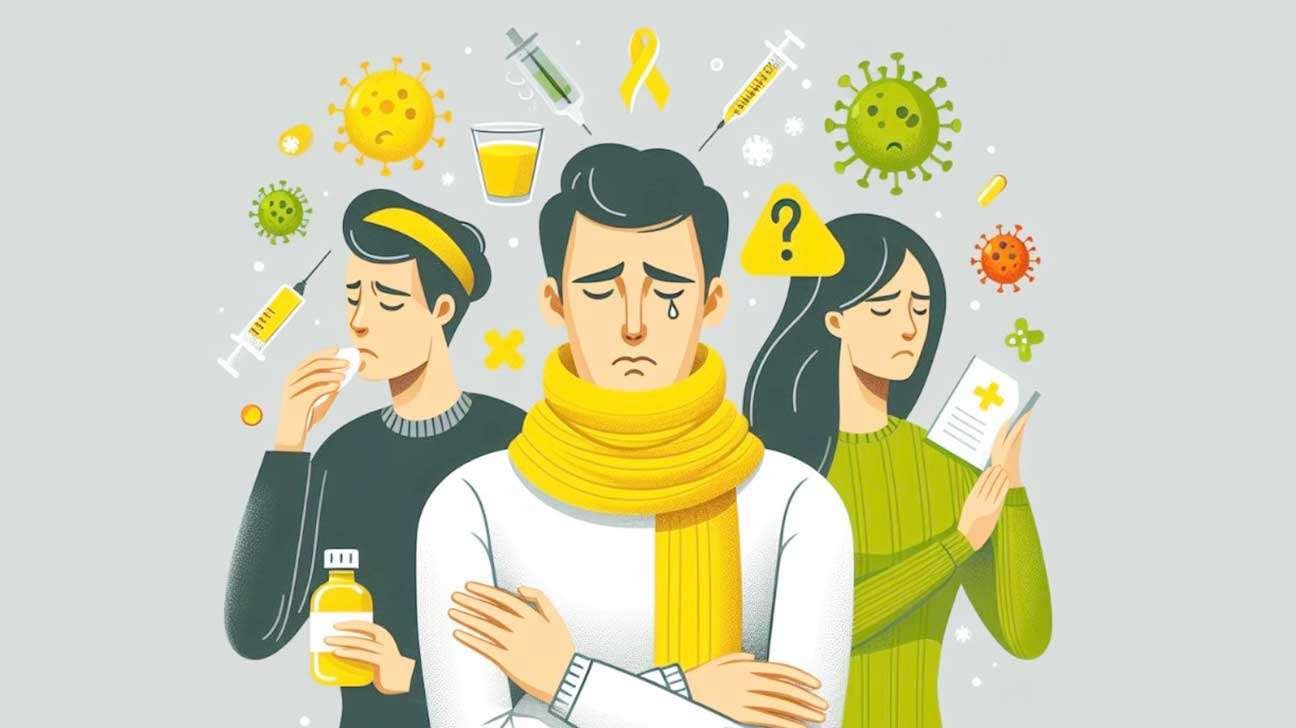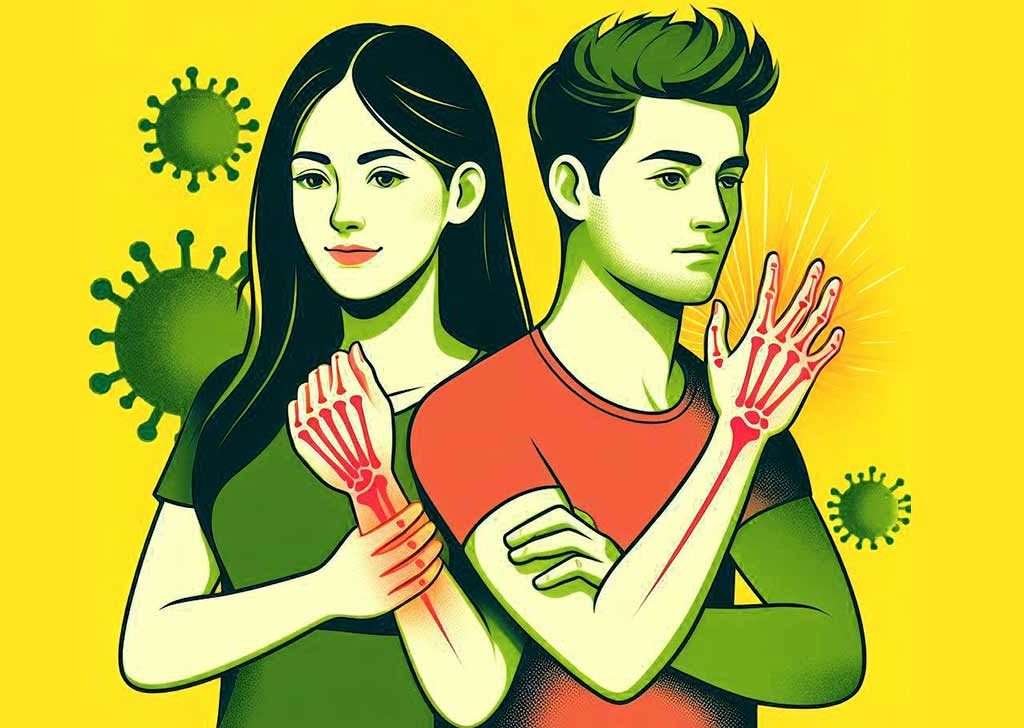Here’s a comprehensive guide on cold & flu, including their causes, symptoms, prevention, treatment, and when to seek medical attention.
Cold & Flu: Overview
Cold and flu are both viral infections that affect the respiratory system. While they share many symptoms, they are caused by different viruses and have varying levels of severity.
Causes
1. Cold
- Causes: The common cold is primarily caused by rhinoviruses but can also be triggered by other viruses such as coronaviruses and adenoviruses.
- Transmission: Colds are highly contagious and spread through respiratory droplets when an infected person coughs or sneezes. They can also spread by touching contaminated surfaces and then touching the face.
2. Flu (Influenza)
- Causes: The flu is caused by influenza viruses, with types A and B being the most common in seasonal outbreaks.
- Transmission: Similar to colds, the flu spreads through respiratory droplets and contaminated surfaces. Flu viruses can also be more severe and lead to more significant health complications.
Symptoms
1. Cold Symptoms
- Runny or stuffy nose
- Sneezing
- Sore throat
- Mild headache
- Cough
- Low-grade fever (sometimes)
2. Flu Symptoms
- High fever (often over 100°F or 37.8°C)
- Chills and sweats
- Severe fatigue and weakness
- Muscle or body aches
- Headaches
- Dry cough
- Sore throat
- Runny or stuffy nose
Prevention
To reduce the risk of catching a cold or flu, consider the following preventive measures:
- Vaccination: The flu vaccine is the most effective way to prevent influenza and its complications. It is recommended annually, especially for high-risk groups (e.g., elderly, young children, and individuals with chronic health conditions).
- Good Hygiene: Regular handwashing with soap and water for at least 20 seconds, especially before eating or after being in public places, can help prevent the spread of viruses.
- Avoid Close Contact: Stay away from individuals who are sick, and practice physical distancing, especially during flu season.
- Cover Coughs and Sneezes: Use a tissue or your elbow to cover your mouth and nose when coughing or sneezing to reduce the spread of respiratory droplets.
- Healthy Lifestyle: Maintaining a balanced diet, exercising regularly, staying hydrated, and getting enough sleep can help support a strong immune system.
Treatment
1. Cold Treatment
- Rest and Hydration: Getting plenty of rest and drinking fluids can help speed up recovery.
- Over-the-Counter Medications: Antihistamines, decongestants, and cough suppressants can alleviate symptoms. Pain relievers like acetaminophen or ibuprofen can help with sore throats and headaches.
2. Flu Treatment
- Antiviral Medications: Prescription antiviral medications (e.g., oseltamivir or zanamivir) can reduce the duration and severity of flu symptoms if taken within the first 48 hours of symptom onset.
- Rest and Hydration: Similar to cold treatment, rest and fluid intake are crucial for recovery.
- Over-the-Counter Medications: Pain relievers and cough medications can help manage symptoms.
When to Seek Medical Attention
Seek medical care if you experience:
- Difficulty breathing or shortness of breath
- Chest pain or pressure
- Severe headache
- Confusion or altered mental status
- Persistent vomiting
- Symptoms that improve but then return with fever and worse cough
Conclusion
Cold and flu are common illnesses that can significantly affect your daily life. By understanding their causes, symptoms, prevention strategies, and treatment options, you can take proactive steps to protect your health. If you have concerns about your symptoms or how to manage them, consult a healthcare professional for guidance.
Additional Resources
For more information on cold and flu, consider visiting reputable organizations such as:
- Centers for Disease Control and Prevention (CDC)
- World Health Organization (WHO)
- National Institutes of Health (NIH)
If you have any specific questions or need further information, feel free to ask!

Difference Between a Cold & Flu
Colds and flu are both respiratory illnesses caused by viruses, but they are caused by different types of viruses and have some distinct differences. Here are detailed differences between a cold and the flu:
Causes:
- Cold: The common cold can be caused by various viruses, with rhinoviruses being the most common. Other viruses such as coronaviruses and adenoviruses can also cause colds.
- Flu: Influenza is caused by influenza viruses, primarily types A and B. These viruses can lead to more severe respiratory infections compared to the common cold.
Onset and Severity:
- Cold: Symptoms typically develop gradually over a few days and are generally milder compared to the flu.
- Flu: Symptoms often come on suddenly and are usually more severe than those of a cold. The flu can lead to more serious complications such as pneumonia, especially in vulnerable populations.
Symptoms:
- Cold: Common symptoms include a runny or stuffy nose, sneezing, coughing, and a sore throat. Fever is uncommon in adults but can occur in children.
- Flu: Symptoms include a sudden onset of fever, chills, muscle aches, fatigue, cough, sore throat, and sometimes gastrointestinal symptoms like nausea and vomiting.
Fever:
- Cold: Fever is uncommon in adults with a cold but can occur in children.
- Flu: Fever is a common symptom, often with temperatures above 100.4°F (38°C), and it is one of the distinguishing features between a cold and the flu.
Duration:
- Cold: Symptoms usually last for about a week, though a lingering cough can persist for more extended periods.
- Flu: Symptoms are generally more severe and can last for a week or longer. Fatigue and weakness may persist for several weeks.
Complications:
- Cold: Colds usually don’t lead to serious complications but can exacerbate underlying respiratory conditions in some individuals.
- Flu: The flu can lead to more severe complications, such as pneumonia, bronchitis, sinus infections, and, in rare cases, can be life-threatening.
Age Groups Affected:
- Cold: People of all ages can get colds.
- Flu: The flu can affect individuals of all ages, but certain populations, such as the elderly, young children, pregnant women, and those with weakened immune systems, are more susceptible to severe complications.
It’s important to note that these are general trends, and individual cases can vary. If you’re experiencing severe symptoms or are in a high-risk group, it’s advisable to seek medical attention. Additionally, practicing good hygiene, such as regular handwashing, can help prevent the spread of both cold and flu viruses.
Symptoms
Both colds and the flu (influenza) are respiratory illnesses caused by viruses, but they are caused by different viruses and have some distinct differences. Here’s a detailed comparison of the symptoms of a cold and the flu:
Common Cold:
- Onset: Symptoms usually develop gradually.
- Fever: Mild or absent in adults, but children may experience a low-grade fever.
- Body Aches: Mild or moderate body aches.
- Fatigue: Mild fatigue is common.
- Cough: Generally a mild cough.
- Sneezing: Common.
- Sore Throat: Common.
- Nasal Congestion: Often present, with a runny or stuffy nose.
- Headache: Mild headache.
- Duration: Symptoms typically last a week or so.
Influenza (Flu):
- Onset: Symptoms come on suddenly and can be severe.
- Fever: Often high (100°F to 104°F or even higher) and can last 3-4 days.
- Body Aches: Severe body aches and pains are common.
- Fatigue: Can be extreme and last for several weeks.
- Cough: Can be severe and may last for weeks.
- Sneezing: Less common.
- Sore Throat: Less common.
- Nasal Congestion: May be present but less prominent than in a cold.
- Headache: Common and can be intense.
- Gastrointestinal Symptoms: Some people may experience nausea, vomiting, and diarrhea, though this is more common in children than adults.
- Complications: Flu can lead to serious complications, such as pneumonia, bronchitis, and sinus infections, and can be particularly dangerous for certain populations like young children, elderly individuals, and those with weakened immune systems.
Causes of Cold & flu
Cold and flu are both respiratory illnesses, but they are caused by different viruses. The common cold is typically caused by rhinoviruses, while influenza (flu) is caused by influenza viruses. Here are the details of the causes of cold and flu:
Common Cold:
- Rhinoviruses: These viruses are the most common culprits behind the common cold. There are more than 100 different types of rhinoviruses, making it challenging for the immune system to build lasting immunity.
- Coronaviruses: Some strains of coronaviruses, such as the ones responsible for the common cold, can cause mild upper respiratory symptoms.
- Adenoviruses: Another group of viruses that can cause cold-like symptoms, including sore throat, cough, and congestion.
- Enteroviruses: These viruses are more common in late spring and early fall, and they can cause cold-like symptoms.
- Human Parainfluenza Viruses: These viruses can cause upper and lower respiratory infections, including cold symptoms.
- Human Respiratory Syncytial Virus (RSV): This virus is a common cause of respiratory tract infections in children and can contribute to cold symptoms.
Influenza (Flu):
- Influenza A, B, and C Viruses: Influenza viruses are categorized into three types – A, B, and C. Influenza A and B viruses are the primary causes of seasonal flu. Influenza C is less common and typically causes milder symptoms.
- Antigenic Drift and Shift: Influenza viruses are known for their ability to undergo changes in their surface proteins (antigenic drift and shift), making it challenging for the immune system to recognize and combat them effectively. This is why new flu vaccines are developed each year to target the prevalent strains.
- Zoonotic Transmission: Influenza A viruses can infect animals, and occasionally, these viruses can jump from animals to humans, causing novel strains with pandemic potential. Examples include the H1N1 strain in 2009.
- Airborne Transmission: Influenza is highly contagious and spreads through respiratory droplets produced when an infected person talks, coughs, or sneezes. It can also spread by touching a surface or object with the virus on it and then touching the face.
- Seasonal Variation: The flu tends to be more prevalent during the fall and winter months, with seasonal variations in different regions.
Both cold and flu are contagious and can spread easily from person to person. Good hygiene practices, such as frequent handwashing, covering coughs and sneezes, and staying home when sick, can help prevent the spread of these viruses. Additionally, vaccines are available for the flu, providing protection against specific strains of influenza viruses.

Treatment of Cold & Flu
The common cold and the flu (influenza) are viral infections that affect the respiratory system. While they share some symptoms, they are caused by different viruses and have distinct characteristics. Here are detailed explanations of the treatment options for both the common cold and the flu:
Cold:
Rest and Hydration:
- Adequate rest allows the body to focus on fighting the virus.
- Stay well-hydrated by drinking plenty of fluids, such as water, herbal teas, and clear broths.
Over-the-Counter (OTC) Medications:
- Pain relievers/fever reducers: Acetaminophen (Tylenol) or ibuprofen can help alleviate pain and reduce fever.
- Decongestants: These help relieve nasal congestion. Common decongestants include pseudoephedrine and phenylephrine.
- Cough suppressants and expectorants: These can help with cough symptoms. Guaifenesin is an example of an expectorant.
Nasal Saline Sprays:
These can help relieve nasal congestion and improve breathing.
Warm Salt Gargle:
Gargling with warm salt water can soothe a sore throat.
Humidifiers:
Adding moisture to the air with a humidifier can help relieve congestion and soothe irritated nasal passages.
Vitamin C:
While the evidence is mixed, some people find that vitamin C supplements may help reduce the duration and severity of a cold.
Influenza (Flu):
Antiviral Medications:
Prescription antiviral drugs like oseltamivir (Tamiflu), zanamivir (Relenza), or baloxavir marboxil (Xofluza) can help reduce the severity and duration of the flu if taken early.
Rest and Hydration:
Similar to the common cold, rest and hydration are crucial for recovery.
OTC Medications:
Pain relievers/fever reducers, such as acetaminophen or ibuprofen, can help manage symptoms.
Inhalation Therapies:
For individuals with severe respiratory symptoms, inhalation therapies like bronchodilators may be prescribed.
Hospitalization:
Severe cases of influenza may require hospitalization, especially for individuals at high risk of complications (e.g., elderly, young children, pregnant women, and those with underlying health conditions).
Prevention (Vaccination):
The best way to prevent the flu is through annual vaccination.
General Recommendations for Both:
Isolation:
Stay home to avoid spreading the virus to others.
Good Hygiene:
- Wash hands frequently with soap and water.
- Use tissues or elbows to cover your mouth and nose when coughing or sneezing.
Avoid Smoking:
Smoking can exacerbate respiratory symptoms, so it’s advisable to avoid smoking during illness.
- It’s important to note that antibiotics are not effective against viral infections like the common cold or flu. If symptoms persist or worsen, it’s advisable to consult with a healthcare professional for personalized advice and possible further evaluation.

Remedies for Cold & Flu
General information on home remedies that people often use to alleviate symptoms associated with the common cold and flu. It’s important to consult with a healthcare professional for personalized advice, especially if symptoms are severe or persist.
- Rest and Hydration
- Warm Saltwater Gargle
- Steam Inhalation
- Hot Tea with Honey and Lemon
- Over-the-Counter Medications
- Nasal Saline Irrigation
- Chicken Soup
- Rest Your Voice
- Warm Compress
- Proper Nutrition
- Stay Warm
Remember, these remedies are generally supportive and may help alleviate symptoms, but they do not cure the cold or flu. If symptoms persist, worsen, or if you have underlying health conditions, it is crucial to seek advice from a healthcare professional. Additionally, some individuals, such as pregnant women or those with certain medical conditions, should consult their healthcare provider before using certain remedies.
Natural Remedies
Natural remedies can help alleviate symptoms of a cold and support the body’s immune system. Keep in mind that while these remedies may provide relief, they are not a substitute for medical advice, especially if you have a severe or persistent condition. Here are some natural remedies for the common cold:
- Stay Hydrated
- Rest
- Warm Salt Gargle
- Steam Inhalation
- Honey and Lemon
- Ginger Tea
- Chicken Soup
- Echinacea
- Probiotics
- Nasal Saline Rinse
- Restorative Herbs
- Vitamin C-Rich Foods
- Garlic
- Hydration and Warmth
- Peppermint Oil
Remember that individual responses to these remedies can vary, and it’s essential to listen to your body. If symptoms persist or worsen, consult a healthcare professional for proper diagnosis and treatment.
Importance of Getting a flu shot
Getting a flu shot is important for several reasons:
- Prevention of Influenza: The primary purpose of a flu shot is to protect you from the influenza virus. Influenza can lead to severe illness, hospitalization, and even death, particularly in vulnerable populations such as young children, the elderly, and those with weakened immune systems.
- Reducing Severity of Symptoms: Even if you get the flu after receiving a flu shot, the vaccine can still reduce the severity and duration of symptoms. It may also lower the risk of complications and hospitalization.
- Community Protection (Herd Immunity): Getting vaccinated helps protect those who are unable to receive the vaccine, such as infants, elderly individuals, or those with certain medical conditions. When a significant portion of the population is immunized, it can help prevent the spread of the virus within the community.
- Economic Impact: Influenza outbreaks can have a significant economic impact due to increased healthcare costs, productivity loss, and absenteeism from work and school. Vaccination helps mitigate these economic burdens by preventing the spread of the virus.
- Public Health Measures: In times of health crises, such as the COVID-19 pandemic, it is essential to reduce the burden on healthcare systems. By preventing the flu through vaccination, resources can be better allocated to address other health challenges.
- Personal Protection: The flu can be a serious and debilitating illness. Getting vaccinated is a simple and effective way to protect yourself and your loved ones from the potentially severe consequences of influenza.
- Yearly Variations in the Virus: The influenza virus can change from year to year. Getting an annual flu shot is crucial as it helps provide protection against the specific strains of the virus that are expected to be most prevalent in a given flu season.
It’s important to note that while the flu shot is highly recommended, it may not provide complete immunity. However, it significantly reduces the risk of severe illness and complications associated with influenza. Consult with your healthcare provider to determine the most appropriate vaccination schedule for you.
What Are the Symptoms of Cold & Flu in Kids and How’s It Treated?
In children, the symptoms of the flu (influenza) can be similar to those in adults, but they may manifest differently. Common symptoms include:
- Fever: A high fever is a common symptom of the flu in children. It can come on suddenly and may be accompanied by chills.
- Cough: Children with the flu often have a persistent cough, which can be dry or produce phlegm.
- Sore Throat: A sore throat is a common symptom, and it can be accompanied by discomfort and difficulty swallowing.
- Runny or Stuffy Nose: Nasal congestion or a runny nose is common, and this can contribute to discomfort and irritability.
- Headache: Children may experience headaches as a symptom of the flu, often in conjunction with other symptoms.
- Muscle or Body Aches: Body aches and muscle pain are common, and children may complain of feeling tired or lethargic.
- Fatigue: The flu can cause significant fatigue and weakness in children, leading to a decreased interest in usual activities.
- Vomiting and Diarrhea: Some children, especially younger ones, may experience gastrointestinal symptoms such as vomiting and diarrhea.
Treatment for the flu in children generally involves supportive care to alleviate symptoms and promote recovery. Here are some general recommendations:
- Rest: Ensure your child gets plenty of rest to help their body recover.
- Hydration: Encourage fluids to prevent dehydration, especially if your child has a fever.
- Fever Management: Use over-the-counter fever-reducing medications as recommended by your child’s healthcare provider.
- Cough Medicine: For children with a persistent cough, over-the-counter cough medicine may be recommended by a healthcare professional. However, it’s essential to follow the age-specific guidelines and consult with a healthcare provider.
- Antiviral Medications: In some cases, especially for children at higher risk of complications, antiviral medications may be prescribed by a healthcare provider. These medications work best when started early in the course of illness.
It’s important to consult with your child’s healthcare provider for guidance on appropriate treatment based on their specific symptoms and health history. If your child develops severe symptoms or if you have concerns about their well-being, seek medical attention promptly.



